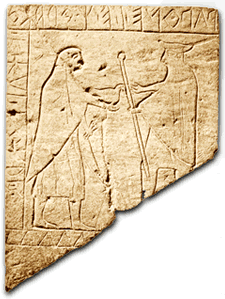The
enigma of the Venetic script 2.
The Venetic Inscriptions
About 400 stone and metal tablets, urns and implements dated about
400 BC, found near Padua on the site of the rich Este culture, is
all that remains of the culture that flourished in the area more
than 2000 years ago. Some inscriptions are in Latin script, 200
in the ancient Venetic script. Both the script and the language
had till recently resisted attempts at deciphering.
We
do not know what other materials may have been used and what other
documents may have been lost through the past two millennia, so
we are limited to the context of the tablets and purposes for which
they were used. Within this framework the tablets offer considerable
insight into the character of the Veneti and the way they viewed
the world.
A number of archaeological
discoveries give strong evidence that Este was an important centre
of Venetic culture in 7th to 4th century BC, with a great shrine
to the god (or goddess) Reitia and more importantly, a school for
scribes. Among numerous finds that include small bronze statues,
various tools and weapons, vases, clasps, money, were 200 inscriptions
in the Venetic script and the so-called Alphabet Tablets, which
were thought to contain the key to the mystery.
|
|
Matej
Bor, Slovenian poet and linguist had studied the problem of the
Venetic script over a number of years. In contrast to the prevailing
opinion, he believed in the Slavic
origin of the Venetic language (rather than Italic), He found
enough indicators to warrant an investigation based on this premise.
As
it sometimes happens, Bor was once more studying Tablet Es 24
containing the mysterious word akeo, when he had a flash
of intuition. The scholars had read the inscription of rows of
identical letters starting from the bottom, and came up with the
repetitions of akeo.
|

The
Venetic Bull found in Brezice, Slovenia -
probably served as handle of the vessel
|
|
They had a sense of humour, enjoyed their wine, sent their dead
from this world with poetry, humour and encouragement, prayed
to their god for health and safety. They also loved word plays
and riddles. The grammar tablet which led to the decyphering of
the script contained such a riddle.
The
man who finally cracked the mystery of Venetic script was Slovenian
poet and linguist Matej Bor. He had for some time held that Venetic
language was Slavic, or even Slovenian in origin and set about
solving the ancient puzzle based on that premise.
His
success, when he found the entry to the puzzle, was swift and
remarkable. The tablet marked Es
24 which led to Bor’s discovery of the verb jekat, contains on the bottom row among
the consonants also several vowels. Veneti like Etruscans often
left out vowels, especially those that were not accented or were
reduced. Bor wondered if the row of letters contained a riddle
for the students - a saying or a proverb. His premise was confirmed.
When Bor inserted suitable vowels, the resulting version was very
close to the modern Slovenian.
VIDIJ
TI KI
LIMINI POŠIRIS TU BOGA (text with inserted vowels)
Videc,
ki tablice razširjaš tu boga
Seer, thou who spreadest here the tablets of god
The
most numerous among the tablets are funeral inscriptions. They
speak of fire, of peace and sorrow for the departed. and are often
moving and poetical. Considering the limited context of the inscriptions,
the range is great. On stone, metal, urn and implement there are
inscribed short pithy invocations to the god Reitia – against
illness or dangers of travel, advice to the drinker, warnings
about dangers of fast driving, salutations, prayers and protective
charms. There are also riddles and inscriptions on tools and weapons,
ensuring best possible effect for the user. While all give an
insight into these ancient people’s thinking and way of life,
some are more than that. They demonstrate an unexpected level
of sophistication.
|
 Pa 1
(LLV) Museo Civico di Padova
Pa 1
(LLV) Museo Civico di Padova |
On
the image on the left we have an elaborate gravestone epigram.
The departed is a traveller going on a journey and he is given
a gift and a good luck wish for his journey. There is a hint of
humour, which Bor says is characteristic of the Etruscans, with
whom Veneti probably had links:
PUPTNEI
JEGO RACO JEKUPETARIS
Popotniku
njega raco za na pot
To the traveller his duck for the journey
The
Adriatic Veneti in time came under Roman rule. The inscriptions
were increasingly in Roman script, often interspersed with Venetic
letters and in Venetic language. This is the case with the following
inscription on stone.. It may be regarded as the last example
of a dying tradition. Its frivolous treatment is said to be more
a parody than a gravestone. There is no example among the ancient
Venetic relics of the driver taking two people at the same time
into the next world.
|
NIMU
VOZTIALE GALLEN
Njemu
je vozataj samec
His driver is a bachelor
JAJE
JEKUPETARS
Jojme
popotujocc
Woe is me the traveller
In
view of the relatively small number of inscriptions that have
survived into the present, the variety is onsiderable. Beside
the funeral inscriptions, there are riddles, proverbs, prayers,
crossroad signs, invocations. In conclusion - an ageless salutation
inscribed on a wine jar.
OSTI
JAREJ!
Ostani
mlad!
Stay
young!
|
|
|
 
|
|